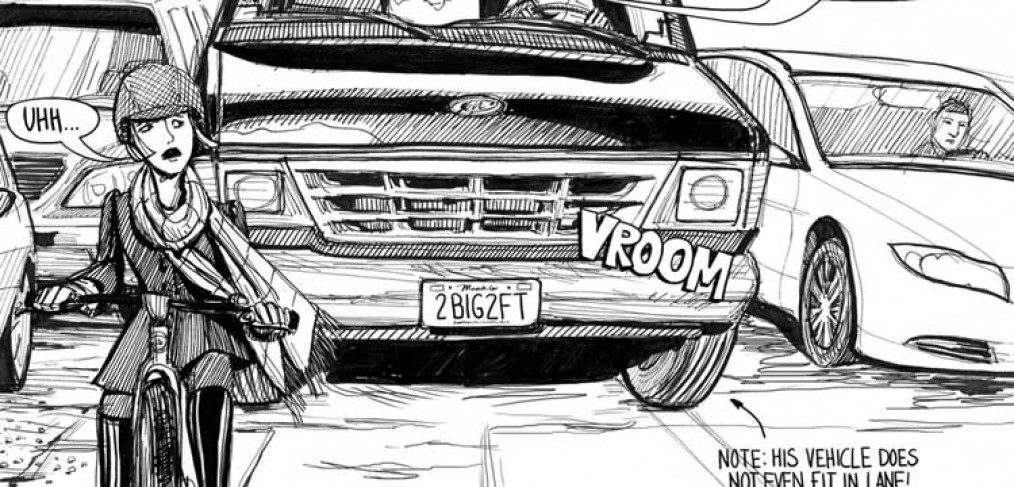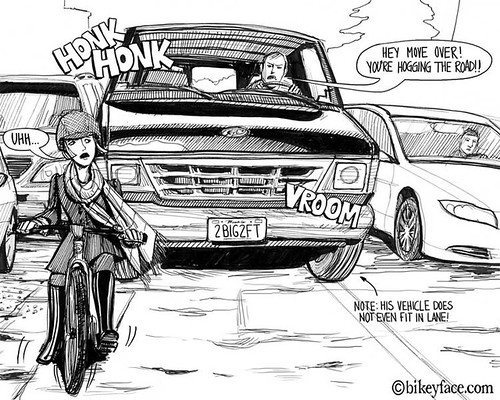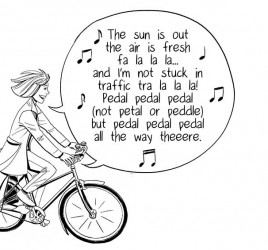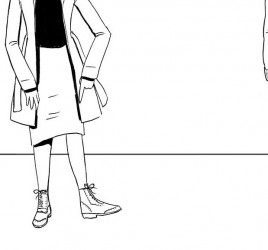
Not a Sideshow
I’ve been taking the lane more and more. In the beginning I was timid and concerned with being polite. However there are drivers who think- no matter what- bikes should be as far to the right as possible. No matter the door zone, pothole, debris, or gutter situation. They’re always eager to push bikes further off to the margins of the road. There have been many moments like this:
Which frequently resulted in large vehicles squeezing by me with mere inches to spare. But enough was enough- I got tired of being a sideshow act on the road. I take the full lane and stay safe. Of course that doesn’t stop the honking.





One thing I’ve noticed about taking the lane: While you do still get some amount of honking and yelling, those who are doing it are almost entirely doing so while waiting behind you or passing completely in the next lane, NOT buzzing you. Given the choice between buzz passing with honking and yelling, versus safe passing with honking and yelling, the choice is clear.
Keri Caffrey at CyclingSavvy.org calls such motorist behavior “territorial honking” or just “incivility”. Sometimes it’s not even from people who’ve been inconvenienced by you at all, or not for very long, they just need to express their opinion of your brazen flaunting of the speed imperative.
I almost always control a lane on any road that has multiple same-direction lanes. On those roads, it’s generally easier for overtakers to change lanes than on two-lane (one each way) roads, and the lanes are almost always too narrow to share side by side. Also those roads tend to have lots of right turn opportunities, so even if there is a shoulder, it’s probably not the best place to be to make yourself relevant to other traffic.
How controlling the lane in a multi-lane situation actually HELPS motorists understand your expectation of them, and makes traffic flow more smoothly than cycling close to the edge. (They see you and change lanes sooner, while they have more opportunity.)
http://commuteorlando.com/wordpress/2010/11/29/helping-motorists-with-lane-positioning/
Bikeyface: It is great to hear about your discovery. I am a cycling instructor. Taking a sufficiently assertive lane position is very important, and I find that the effects of lane position are very poorly understood. Here is a piece you might appreciate.
http://commuteorlando.com/wordpress/2010/11/29/helping-motorists-with-lane-positioning/
I’ve kicked around, with tongue in cheek, a product to help motorists detect a safe passing distance around a commuting cyclist – it would be a thin, whippy titanium rod which would be neon-HiViz-Reflective coated and would stick out to the rider’s left from the back of the bike. The key feature would be a sharpened carbide tip that would produce a visual cue on the side of the passing vehicle if the motorist failed to pass at a safe distance…
In all seriousness, your drawing describes a scenario that virtually ALL cyclists who ride on the road encounter… it takes some guts to hold your line, endure the slings and arrows of those who yell at you and NOT try to go after every oaf who says something you don’t like.
We learned pretty much everything we need to know about this in kindergarten – Ride predictably, obey the laws, DON’T run stop signs or lights, wait your turn, and ride courteously…
ENJOY!
Steve Magas
The Bike Lawyer
I’m in. I’ve often envisioned a very similar product. Or, if I’m in a lousy mood, equipped with a Patriot missile…..
What gets me is when I’m taking the lane, motorists will still pass me approaching the crest of a hill or a blind curve or even crazier, pulling out into on coming traffic on a strait away, forcing other vehicles off the road. These things happen all to often. I ride a Velomobile, a fully faired human powered vehicle and am even passed when I’m doing the speed limit or even exceeding the limit myself, they have to pass.
What idiot gave these idiots a license to drive?
David, I’m not sure how you do this in a velomobile, but on a regular upright bike, I frequently communicate to those behind me when they should not pass.
It depends on the road geometry, of course, but I’m talking about two-lane roads where curves and hill crests are the biggest problems, and the lanes are too narrow to pass without crossing the centerline. If I’m approaching one of these blind spots, I check behind to see if there is traffic about to overtake. If no traffic at all, easy, just move to the middle of the lane until I’m past the blind spot. If traffic is too close behind me to react and I’m not already in the middle, I slow down to try to get them past me before we get too close to the blind spot. Worst case, I sometimes just pull over and let the pack pass before I resume my approach.
If there is traffic behind me but it’s sufficiently far back to react and slow down, I’ll move to the center and give them a stop/slow signal (left arm bend down). Sometimes I’ll also do this if I’m already in a controlling position when I notice them approaching me. It can also be good to move your hand back and forth in a kind of “stay back” motion. Over 90% of time, the motorist understands and respects me. Only occasionally will a jerk will accelerate and pass quickly before the blind spot, usually honking as he does. Yes, it can be hard to keep your cool in that situation.
After we get past the blind spot, if there is traffic slowed behind me AND there is clearly no oncoming traffic, I’ll move back to the right and give them a friendly wave. Sometimes I’ll actually wave them past, but I hesitate to do this too much, because it really should be their decision to pass when it’s safe, not just because I said so. But even if it’s just a wave, I feel it’s an important gesture in keeping good relations with motorists. You’re acknowledging that you delayed them a little, and it’s important to let them know you appreciate that and weren’t just being a jerk.
By the way, I employ exactly the same strategy where there is a line of oncoming cars approaching in the opposing lane, because I know overtakers behind me will not be able to cross the centerline to pass. If I can control the lane until the oncoming traffic passes, I do, then I move to the right again after they are past. Cycling Savvy calls this technique “control and release”. Works just as well as the blind spot scenario, maybe better, because a line of oncoming cars is an even more obvious impediment to overtakers crossing the center line than a blind spot.
Of course, since you mention you’re in a velomobile and can sometimes cruise at the speed limit, I should state that all this assumes that you’re slower than prevailing traffic to begin with.
John.
I have lost count of the motor vehicles that have passed me when I’m in control of the lane, doing the speed limit and so, their behavior forces on coming traffic onto the shoulder.
This has happened in double yellow line marked, no passing zones.
I’ve had public transportation buses greatly exceed the speed limit just to get around me.
John. All of the roads here are two lane and with the aerodynamics of a Velomobile I can easily hit 40 + mph on the slightest descent and bounce a 30′ hill in excess of 25 to 30 mph depending on the approach.
I take the lane at all times on our narrow two lane roads and as mentioned before I will still get passed in a rather dangerous manner even when doing the speed limit.
I can’t turn my head around to see to the rear but I do have two rear view mirrors along with a tail light, brake light, a 400 lumen flasher about 3′ above ground level and turn signals.
On longer climbs where I loose momentum, I will pull over to let a line of motor vehicles pass but I’ve only had to do that twice in the past.
Massachusetts where I live requires motor vehicle when passing bicycles, to completely move out of the travel lane and not move back into it until completely passing the cyclists. It also calls for motorists to “wait” if it isn’t safe to pass a cyclist but as we all know, few motorists know the laws in the jurisdictions that they live in.
This happens to me as well, but what amazes me more is that the oncoming traffic rarely honks, and sometimes oncoming cars will even slow down, pull over, and yield to the unsafely passing traffic!
Great observation Ben. I hadn’t really noticed that but now that you mention it, it really is bizarre. The motoring mentality reigns supreme. Just yesterday I was on a flat stretch of road traveling along between 28 to 30 mph in a 25 mph zone and I was still passed by at least a dozen high speed cars. Some of which ran on coming traffic onto the shoulder. Guess who was getting honked at by a number of motorists? Me.